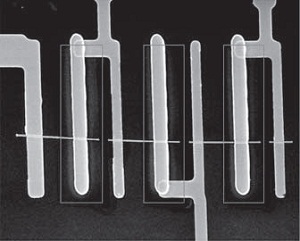Nano remains one of the most scintillating words in the whole of photovoltaics research. The idea engineering materials at a near atomic scale to create more efficient, less expensive photovoltaics has created numerous types of new solar cells, using everything from quantum wells to nanoantennas, nanowires and other nano-scale technologies.
Most recently, the Lawrence Berkeley National Laboratory (LBL) in California introduced new research that created solar cells in ambient conditions in a liquid bath.
 The research, led by Professor Peidong Yang, a chemist at LBL’s Materials Sciences Division, showed that cadmium-sulfide nanowires deposited through a process called cation exchange (where positively charged ions in a solution are exchanged with cations on mineral or organic matter) could yield photovoltaic cells that are up to 5.4 percent efficient at converting sunlight to electricity.
The research, led by Professor Peidong Yang, a chemist at LBL’s Materials Sciences Division, showed that cadmium-sulfide nanowires deposited through a process called cation exchange (where positively charged ions in a solution are exchanged with cations on mineral or organic matter) could yield photovoltaic cells that are up to 5.4 percent efficient at converting sunlight to electricity.
“This happened within one year,” Yang said.
This research builds on research done by Yang’s group into silicon photovoltaic core-shell nanowires.
They developed a method, about a year ago, for creating photovoltaic nanowires in which a p-type silicon nanowire was surrounded by a layer of n-type silicon.
“This geometry effectively turned each individual nanowire into a photovoltaic cell and greatly improved the light-trapping capabilities of silicon-based photovoltaic thin films,” LBL said in a press release.
Yang’s group is moving forward on two fronts with the new research now.
Firstly, reducing the amount of hazardous materials in the cell and increasing the efficiency of resulting devices.
“We can now apply such concepts to earth-abundant, non-toxic semiconductor materials, using a low-temperature solution process, and also achieve decent energy conversion efficiency,” Yang said. “Even though in the current system, we still have some cadmium sulfide components in the final device, we are now working toward eliminating cadmium elements and replacing it with other earth-abundant and non-toxic elements.”
The group also is working to increase the efficiency of resulting devices.
“We are in the process increasing the copper sulfide shell thickness at this moment, which should lead to higher efficiency,” Yang said.
The research, which was published in Nature Nanotechology in August, showed that Yang and his team were able to create a highly coherent interface using low-temperature solution cation exchange chemistry.
“Through this study, we clearly demonstrated that a high-quality coherent interface within the nanostructure solar cell is the key structural feature in order to achieve better energy conversion efficiency,” Yang said.
 Follow
Follow